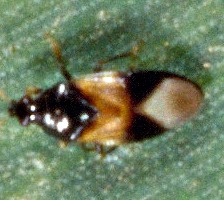 Minute pirate bugs are predatory insects belonging to the Anthocoridae family. There are up to six hundred species worldwide of which about seventy species occur in North America. Most are generalist predators but a few are specialists. The most common species east of the Rockies is Orius insidious (also called the insidious flowerbug) while Orius tristicolor is the most common species west of the Rockies. The small bugs are 1/8” long or less, have oval shaped, flat bodies, and are black and silver with clear overlapping wings that lie under rigid wing covers and extend beyond the abdomen. They have piercing, sucking mouth parts used to suck the body juices from the prey.
Minute pirate bugs are predatory insects belonging to the Anthocoridae family. There are up to six hundred species worldwide of which about seventy species occur in North America. Most are generalist predators but a few are specialists. The most common species east of the Rockies is Orius insidious (also called the insidious flowerbug) while Orius tristicolor is the most common species west of the Rockies. The small bugs are 1/8” long or less, have oval shaped, flat bodies, and are black and silver with clear overlapping wings that lie under rigid wing covers and extend beyond the abdomen. They have piercing, sucking mouth parts used to suck the body juices from the prey.
Minute pirate bugs are common in crop lands, pasture land, gardens, and landscapes. In early spring when prey is scarce they feed on the pollen and plant juices but they are primarily meat-eaters and switch to prey as they become available. The diet of minute pirate bugs includes aphids, lace bugs, Mexican bean beetle larvae, scales, spider mites, thrips, corn earworms, leafhoppers, psyllids, white flies, small caterpillars, and a variety of insect eggs.
The bugs overwinter as adults and emerge in spring feeding primarily on plants but without damaging them. The females lay their eggs in plant tissue and in three to five days nymphs emerge that pass through five instars before becoming adults. The nymphs are yellowish to reddish-brown in color and wingless but have sucking mouth parts like adults and have the same diet. The life cycle from egg to adult takes about twenty days.
Attracting and maintaining a population of minute pirate bugs involves having plants for cover, for food especially in spring, and to attract prey. Garden plants that will create a good habitat for minute pirate bus include spring flowering shrubs, asters, basket of gold, baccharis, boltonia, Cosmos bipinnatus, cinquefoil, coreopsis, Culver’s root, daisies, goldenrod, laceflower, Marigold (Tagetes tenuifolia) meadowsweet, verbena, wallflower, yarrow, and yellow coneflower. Useful herbs include boneset, caraway, coriander, fennel, spearmint, feverfew, and oregano. Field plants include alfalfa and buckwheat. In addition to providing plants to attract minute pirate bugs, broad spectrum pesticides and soil-applied systemic pesticides should be avoided.